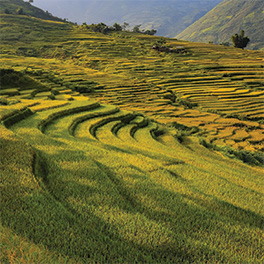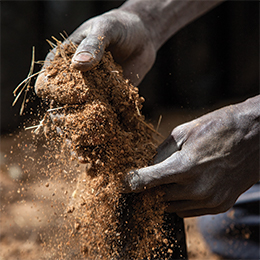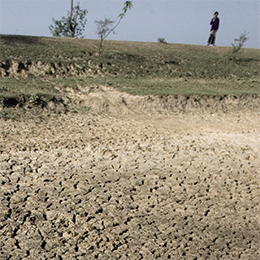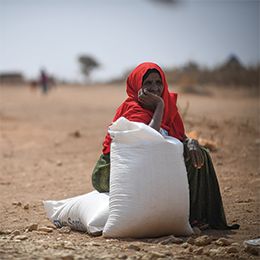Preliminary Pages
Preface
Setting the scene
Human use of land and water for agriculture has not yet peaked, but all evidence points to slowing growth in agricultural productivity, rapid exhaustion of productive capacity and generation of environmental harm. Taking production that is more environmentally responsible and climate smart to scale can reverse trends in the deterioration of land and water resources and promote inclusive growth. This aligns with the aspirations of the FAO strategic framework: “better production, better nutrition, a better environment and a better life”.
The past decade has seen the advent of several important global policy frameworks including the 2030 Agenda for Sustainable Development, the Paris Agreement on climate change, the Sendai Framework for Disaster Risk Reduction 2015–2030, the Small Island Developing States Accelerated Modalities of Action, the New Urban Agenda and the Addis Ababa Action Agenda on Financing for Development. The frameworks have introduced the Sustainable Development Goals (SDGs), nationally determined contributions (NDCs) and land degradation neutrality (LDN). In particular, there are dedicated SDGs for water, and targets for land and soil health. The frameworks are accompanied by global assessments of natural resources, including soils, forestry, biodiversity, desertification and climate. The state of the world’s land and water resources for food and agriculture: Systems at breaking point (SOLAW 2021) report aims to take stock of the implications for agriculture and recommend solutions for transforming the combined role of land and water in global food systems.
Taking production that is more environmentally responsible and climate smart to scale can reverse trends in the deterioration of land and water resources and promote inclusive growth.

The uncertainty of climate change and the complex feedback loops between climate and land present agriculture with amplified levels of risk that need to be managed. A global view points to a convergence of factors putting unprecedented pressure on land and water resources, leading to a set of human impacts and shocks in the supply of agricultural products, notably food. The SOLAW 2021 report argues that a sense of urgency needs to prevail over a hitherto neglected area of public policy and human welfare, that of caring for the long-term future of land, soil and water.
Shocks, including severe floods, droughts and the COVID-19 pandemic tend to divert attention away from development priorities. International finance institutions warn of the widening fault lines between developed and developing countries in meeting global goals while facing resurgent infections and rising death tolls from COVID-19. Recovery programmes offer opportunities to address urgencies and kick-start the process of change, including in land and water management.
Taking care of land, water and particularly the long-term health of soils is fundamental to accessing food in an ever-demanding food chain.

Land, soil and water form the basis of the FAO commitment to the changes advocated in the 2021 United Nations Food Systems Summit. However, recognition and actions are needed to redirect the focus onto the land, on which 98 percent of the world’s food is produced. Taking care of land, water and particularly the long-term health of soils is fundamental to accessing food in an ever-demanding food chain, guaranteeing nature-positive production, advancing equitable livelihoods, and building resilience to shocks and stresses arising from natural disasters and pandemics. They all start from land and water access and governance. Sustainable land, soil and water management also underpins nutritious, diverse diets and resource-efficient value chains in the shift to sustainable consumption patterns.
What SOLAW 2021 says
The SOLAW 2021 report comes at a time when human pressures on the systems of land, soils and fresh water are intensifying, just when they are being pushed to their productive limits. The impacts of climate change are already constraining rainfed and irrigated production over and above the environmental consequences resulting from decades of unsustainable use. This synthesis report presents the main findings and recommendations of the full SOLAW 2021 report and its annexes and background reports, which will be published in early 2022.
The SOLAW 2021 report builds on the concepts and conclusions given in the previous SOLAW 2011 report. Much has happened in the intervening years. Recent assessments, projections and scenarios from the international community paint an alarming picture of the planet’s natural resources – highlighting overuse, misuse, degradation, pollution and increasing scarcity. Rising demands for food and energy, competing industrial, municipal and agricultural uses, and the need to conserve and enhance the integrity of the Earth’s ecosystems and their services make the picture extremely complex and full of interlinkages and interdependencies.
The SOLAW 2021 report adopts the driver–pressure–state–impact–response (DPSIR) approach. This is a well-established framework for analysing and reporting important and interlinked relationships among sustainable agricultural production, society and the environment. The DPSIR approach provides a structure to report on cause–effect relationships to arrive at key policy recommendations and enable policymakers to assess the direction and nature of changes needed to advance sustainable management of land and water resources.
The drivers of demand for land and water resources are complex. By 2050, FAO estimates agriculture will need to produce almost 50 percent more food, livestock fodder and biofuel than in 2012 to satisfy global demand and keep on track to achieve “zero hunger” by 2030. Progress made in reducing the number of undernourished people in the early part of the twenty-first century has been reversed. The number has risen from 604 million in 2014 to 768 million in 2020. While prospects for meeting the nutritional requirements of 9.7 billion people by 2050 at the global level exist, problems with local patterns of production and consumption are expected to worsen, with increasing levels of undernourishment and obesity among the steadily growing and mobile population.
Options to expand cultivated land areas are limited. Prime agricultural land is being lost to urbanization. Irrigation already accounts for 70 percent of all freshwater withdrawals. Human-induced land degradation, water scarcity and climate change are increasing the levels of risk for agricultural production and ecosystem services at times and in places where economic growth is needed most.
Most pressures on the world’s land, soil and water resources derive from agriculture itself. The increase in use of chemical (non-organic) inputs, uptake of farm mechanization, and overall impact of higher monocropping and grazing intensities are concentrated on a diminishing stock of agricultural land. They produce a set of externalities that spill over into other sectors, degrading land and polluting surface water and groundwater resources.
The impacts from accumulating pressures on land and water are felt widely in rural communities, particularly where the resource base is limited and dependency is high, and to a certain extent in poor urban populations where alternative sources of food are limited. Human-induced deterioration of land, soil and water resources reduces production potential, access to nutritious food and, more broadly, the biodiversity and environmental services that underpin healthy and resilient livelihoods.
Human-induced land degradation, water scarcity and climate change are increasing the levels of risk for agricultural production and ecosystem services at times and in places where economic growth is needed most.

A central challenge for agriculture is to reduce land degradation and emissions and to prevent further pollution and loss of environmental services while sustaining production levels. Responses need to include climate-smart land management attuned to variations in soil and water processes. Management options are available to increase productivity and production levels if innovation in management and technology can be taken to scale to transition to sustainable agrifood systems. However, none of these can go far without planning and managing land, soil and water resources through effective land and water governance.
Increasing land and water productivity is crucial for achieving food security, sustainable production and SDG targets. However, there is no “one size fits all” solution. A “full package” of workable solutions is now available to enhance food production and tackle the main threats from land degradation, increasing water scarcity and declining water quality.
The SOLAW 2021 report indicates how institutional and technical responses can be packaged to address the challenges of increasing water and food security within land, soil and water domains, and, more widely, across agriculture and food systems. It stresses the importance of integrated approaches in managing land and water resources. Sustainable land management (SLM), sustainable soil management and integrated water resources management (IWRM) are all examples of such approaches, which can be blended with technology innovation, data and policies to accelerate improvement in resource-use efficiency, raise productivity and align progress with SDGs.
Injecting a sense of urgency into making the necessary transformations in the core of the global food system is essential.

An important point to recognize is that many agents of change in the landscape remain excluded from the benefits of technical advances. This applies to disproportionately poorer and socially disadvantaged groups, with most living in rural areas. While technical solutions to specific land and water challenges may be within grasp, much will depend on how land and water resources are allocated. Inclusive forms of land and water governance will be adopted at scale only when there is political will, adaptive policymaking and follow-through investment. A primary focus on land and water governance is essential in creating the transformative changes needed to achieve patterns of sustainable agriculture that can enhance income and sustain livelihoods while protecting and restoring the natural resource base.
Significant complementary efforts will also be needed in food systems beyond the farm to maximize synergies and manage trade-offs in related sectors, particularly energy production. For this to happen, changes in policy, institutional and technical domains that disrupt “business as usual” (BAU) models may prove necessary.
Time is of the essence. Current trends in natural resource depletion indicate production from rainfed and irrigated agriculture is operating at or over the limit of sustainability. Injecting a sense of urgency into making the necessary transformations in the core of the global food system is essential.

